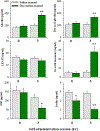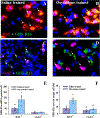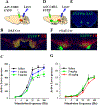Involvement of the ghrelin system in the maintenance of oxycodone self-administration: converging evidence from endocrine, pharmacologic and transgenic approaches
- PMID: 35064236
- PMCID: PMC9133122
- DOI: 10.1038/s41380-022-01438-5
Involvement of the ghrelin system in the maintenance of oxycodone self-administration: converging evidence from endocrine, pharmacologic and transgenic approaches
Abstract
Ghrelin, an orexigenic hormone, has emerged as a critical biological substrate implicated in drug reward. However, the response of the ghrelin system to opioid-motivated behaviors and the role of ghrelin in oxycodone self-administration remain to be studied. Here, we investigated the reciprocal interactions between the endogenous ghrelin system and oxycodone self-administration behaviors in rats and the role of the ghrelin system in brain stimulation reward (BSR) driven by optogenetic stimulation of midbrain reward circuits in mice. Oxycodone self-administration significantly elevated plasma ghrelin, des-acyl ghrelin and growth hormone and showed no effect on plasma LEAP2, a newly identified endogenous ghrelin receptor (GHS-R1a) antagonist. Oxycodone self-administration produced significant decreases in plasma gastric inhibitory polypeptide and insulin. Acquisition of oxycodone self-administration significantly upregulated GHS-R1a mRNA levels in dopamine neurons in the ventral tegmental area (VTA), a brain region critical in drug reward. Pretreatment with JMV2959, a selective GHS-R1a antagonist, dose-dependently reduced oxycodone self-administration and decreased the breakpoint for oxycodone under a progressive ratio reinforcement in Long-Evans rats. The inhibitory effects of JMV2959 on oxycodone self-administration is selectively mediated by GHS-R1a as JMV2959 showed a similar effect in Wistar wildtype but not in GHS-R knockout rats. JMV2959 pretreatment significantly inhibited BSR driven by selective stimulation of VTA dopamine neurons, but not by stimulation of striatal GABA neurons projecting to the VTA in mice. These findings suggest that elevation of ghrelin signaling by oxycodone or oxycodone-associated stimuli is a causal process by which oxycodone motivates oxycodone drug-taking and targeting the ghrelin system may be a viable treatment approach for opioid use disorders.
© 2022. This is a U.S. government work and not under copyright protection in the U.S.; foreign copyright protection may apply.
Conflict of interest statement
Conflict of interest
The authors report no biomedical financial interests or potential conflicts of interests.
Figures





References
-
- Hedegaard H, Bastian BA, Trinidad JP, Spencer M, Warner M. Drugs Most Frequently Involved in Drug Overdose Deaths: United States, 2011–2016. Natl Vital Stat Rep 2018; 67(9): 1–14. - PubMed
Publication types
MeSH terms
Substances
Grants and funding
LinkOut - more resources
Full Text Sources

